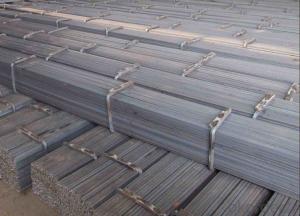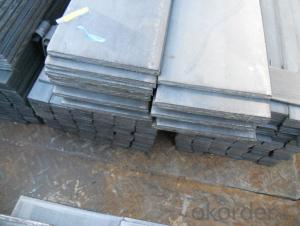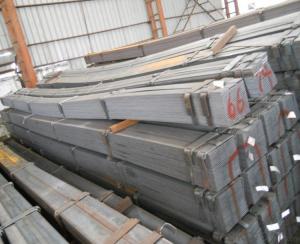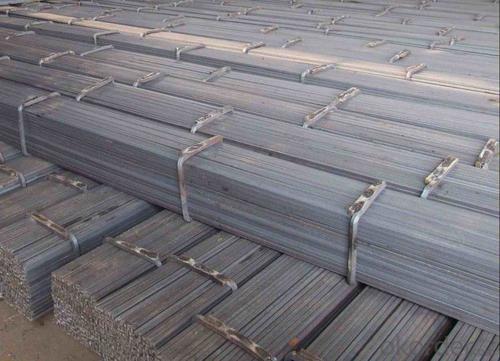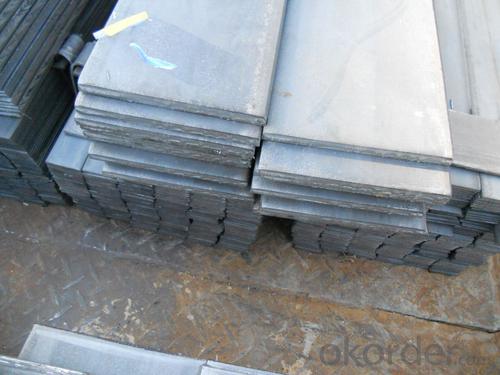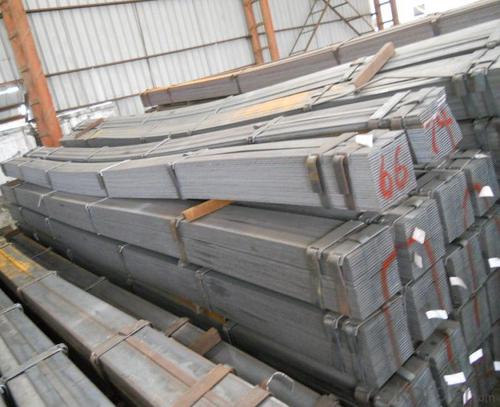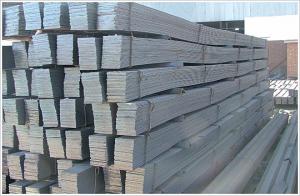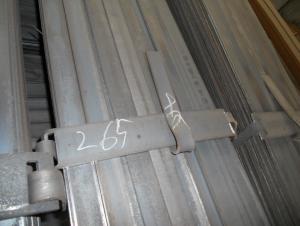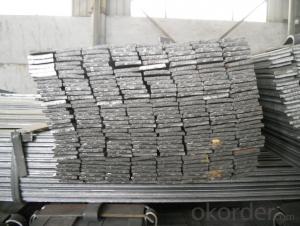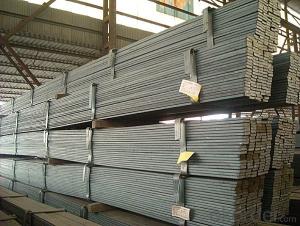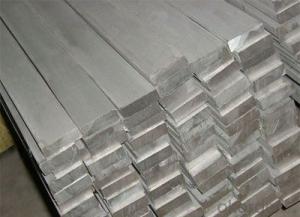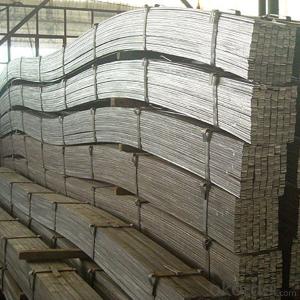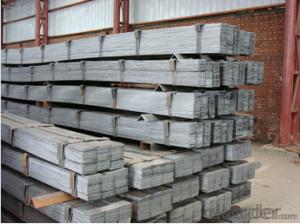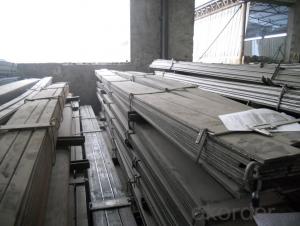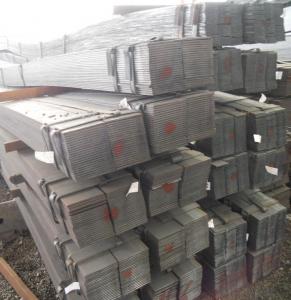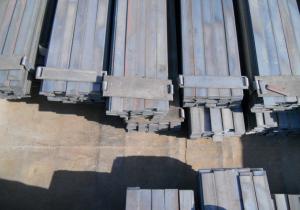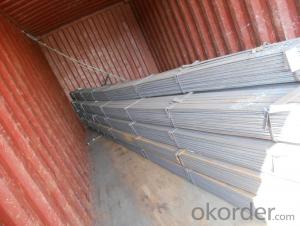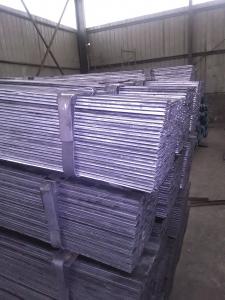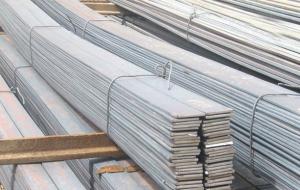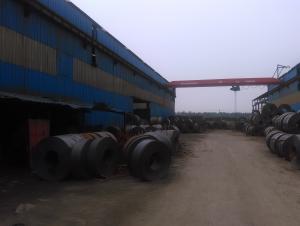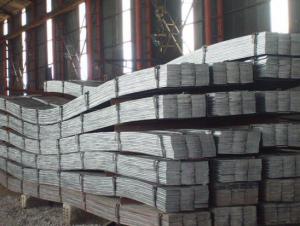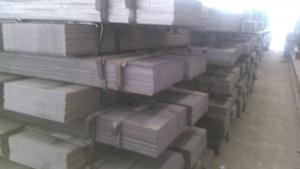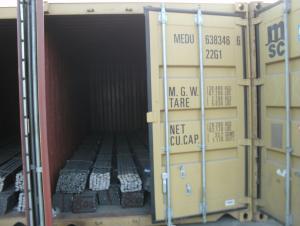High Quality Carbon Steel Flat Bar in Grade Q235
- Loading Port:
- Tianjin
- Payment Terms:
- TT OR LC
- Min Order Qty:
- 25 m.t.
- Supply Capability:
- 100000 m.t./month
OKorder Service Pledge
OKorder Financial Service
You Might Also Like
Specification of Carbon Steel Flat Bar
Commodity: Carbon Steel Flat Bar
Standard: GB,JIS,ASTM,
Material: Q235,SS400 or Equivalent
Brand name: FLATSPACE
Origin place: China
Thickness: 3mm-30mm
Width:20mm-200mm
Length: Max 12m
Certification: SGS/BV
Chemical composition of Q235
Alloy No | Grade | Element(%) | ||||
C
| Mn
| S
| P
| Si
| ||
Q235
|
B
|
0.12—0.20 |
0.3—0.7 |
≤0.045 |
≤0.045
|
≤0.3
|
Physical properties of Q235
Alloy No | Grade | Yielding strength point(Mpa) | Tensile strength (Mpa) | Elongation after fracture(%) | ||||||
Thickness (mm) | Thickness (mm) | |||||||||
≤16 | >16--40 | >40--60 | >60--100 | ≤16 | >16--40 | >40--60 | >60--100 | |||
≥ | ≥ | |||||||||
Q235 |
B |
235 |
225 |
215 |
205 |
375--500 |
26 |
25 |
24 |
23 |
Above sheets show the technical data of Q235,we can also provide other materials similar to Q235.
Usage/Applications of Carbon Steel Flat Bar
Widely used for construction;
Machinery manufacturing;
Iron tower steel structure;
Shipbuilding; Steel grating;
Staircase;
Bridge;
Viaduct;
Railway spare parts;
Boilers making etc.
Packaging & Delivery of Carbon Steel Flat Bar
Packaging Details: The Steel Flat Bars are packed in bundles and loaded in 20 feet/40 feet container, or shipped by bulk cargo ,also we can do as customer's requirements.
Delivery Details:30~45 days upon the receipt of buyer payment by T.T. or L/C.
- Q: Are steel flat bars suitable for indoor or outdoor applications?
- Steel flat bars are suitable for both indoor and outdoor applications.
- Q: Can steel flat bars be used for making industrial equipment or machinery?
- Steel flat bars have multiple applications in the industrial sector due to their versatility and durability. They can be utilized to construct industrial equipment or machinery. With their smooth surface and rectangular shape, flat bars can be easily molded and transformed into various components like brackets, frames, supports, or structural elements required in the mentioned equipment or machinery. The remarkable strength-to-weight ratio of steel ensures that the equipment or machinery built with steel flat bars can endure heavy loads, vibrations, and harsh operating conditions. Furthermore, steel exhibits exceptional heat resistance and can be fortified with coatings to provide protection against corrosion, thus extending the lifespan of the equipment or machinery. In summary, steel flat bars are widely employed in the manufacturing of industrial equipment or machinery due to their robustness, adaptability, and resilience.
- Q: What is the typical weight of a steel flat bar?
- The weight of a steel flat bar can differ based on its size and thickness. Nonetheless, on average, a standard steel flat bar measuring 1 inch in width and 1/4 inch in thickness usually weighs approximately 0.22 pounds per foot. This weight can vary in direct proportion to the dimensions and thickness of the flat bar. It is advisable to consult the manufacturer or supplier for precise weight details regarding a specific steel flat bar.
- Q: What is the price range of steel flat bars?
- The price range of steel flat bars can vary depending on several factors such as the size, grade, and quality of the steel. Generally, the price range for steel flat bars can range from $10 to $100 per bar. However, specialty or high-grade steel flat bars can be priced higher, reaching up to $200 or more. It is recommended to consult with local suppliers or check online sources for the most accurate and up-to-date pricing information.
- Q: How do steel flat bars contribute to the fire resistance of structures?
- Steel flat bars contribute to the fire resistance of structures in several ways. Firstly, steel is a non-combustible material, which means it does not burn or contribute to the spread of fire. This property alone makes steel flat bars an excellent choice for construction in fire-prone areas. Additionally, steel flat bars have a high melting point compared to other materials commonly used in construction. This means that in the event of a fire, steel flat bars will maintain their structural integrity for a longer period of time, providing a secure framework for the building. This is crucial for the safety of occupants and firefighters, as it allows for a longer period of evacuation and firefighting efforts. Furthermore, steel flat bars can act as fire barriers, preventing the spread of flames from one area of the structure to another. When used in conjunction with fire-resistant materials such as gypsum board or concrete, steel flat bars can create compartmentalized spaces that contain the fire, limiting its ability to spread and minimizing the damage caused. Moreover, steel flat bars can help to reinforce the overall strength and stability of a structure, even under extreme heat conditions. This is due to the high tensile strength and durability of steel. By incorporating steel flat bars into the structural design, buildings can be better equipped to withstand the effects of fire and maintain their load-bearing capacity. In summary, steel flat bars contribute to the fire resistance of structures by being non-combustible, maintaining their structural integrity at high temperatures, acting as fire barriers, and enhancing overall structural strength. These properties make steel flat bars an essential component in fire-resistant construction, ensuring the safety and longevity of buildings in the face of fire hazards.
- Q: What is the difference between hot-rolled and forged steel flat bars?
- Both the construction and manufacturing industries favor hot-rolled and forged steel flat bars, but their production methods and resulting properties differ. To create hot-rolled steel flat bars, a billet or slab of steel is heated until it becomes malleable. It is then passed through a series of rollers to achieve the desired shape and dimensions. This process results in a product with a relatively smooth surface finish, although there may be some surface imperfections due to the rolling process. Hot-rolled steel flat bars are renowned for their strength and versatility, making them suitable for a wide array of applications. On the contrary, forged steel flat bars are manufactured by subjecting the steel to high pressure and temperature using a forging press or hammer. This process leads to a more refined and dense grain structure compared to hot-rolled steel. Forged steel flat bars generally possess a smoother surface finish and superior mechanical properties, including increased strength, toughness, and resistance to fatigue. These enhanced properties make forged steel flat bars ideal for applications that require high strength or when the material will be exposed to heavy loads or extreme conditions. In conclusion, the primary distinction between hot-rolled and forged steel flat bars lies in their production methods and resulting properties. Hot-rolled steel flat bars are formed through rolling and provide satisfactory strength and versatility. On the other hand, forged steel flat bars are shaped via high-pressure forging, resulting in a finer grain structure and exceptional mechanical properties. The choice between the two depends on the specific requirements of the application and the desired performance characteristics of the steel flat bar.
- Q: What is the typical yield strength of steel flat bars?
- The typical yield strength of steel flat bars can vary depending on the specific grade of steel used. However, for most common grades of steel, the yield strength typically ranges from 30,000 to 80,000 pounds per square inch (psi). It is important to note that the yield strength can be influenced by factors such as the composition, heat treatment, and manufacturing process of the steel. Therefore, it is recommended to consult the specific material specifications or contact the manufacturer for accurate information regarding the yield strength of steel flat bars.
- Q: Galvanized flat steel how much is one meter?
- Formula of flat steel: width * thickness * 0.00785 (kg/m), zinc coating weight: 1.06Galvanized pipe formula: (outer diameter wall thickness) * wall thickness * 0.02466 * 1.06, DN25 galvanized pipe outer diameter 33.5, GB thickness 3.25, weight: 2.57kg/m, DN32, outer diameter 42.3, wall thickness 3.25, weight: 3.32kg/m. DN stands for nominal caliber.Angle formula (approximate): edge width * thickness * 0.015, 4# angle iron weight 2.422kg/m
- Q: How do steel flat bars contribute to the overall versatility of structures?
- Steel flat bars contribute to the overall versatility of structures in several ways. Firstly, their flat and uniform shape makes them easy to work with and manipulate, allowing for precise and accurate construction. This versatility in shape and size allows steel flat bars to be used in a wide range of structural applications. Secondly, steel flat bars have excellent strength-to-weight ratio, meaning they can provide significant structural support while remaining relatively lightweight. This makes them an ideal choice for structures that require both strength and efficiency, such as bridges, buildings, and industrial frameworks. The high tensile strength of steel also makes it resistant to bending and deformation, which further enhances the durability and stability of structures. Additionally, steel flat bars can be easily welded or bolted together, allowing for efficient connections and the creation of complex structures. This versatility in joining methods enables architects and engineers to design structures that are not only strong and stable, but also aesthetically pleasing. Moreover, steel flat bars can be easily cut and shaped to fit specific design requirements, making them suitable for a variety of architectural styles and functions. Whether it is for columns, beams, braces, or supports, steel flat bars can be customized to meet the unique demands of different construction projects. Furthermore, steel flat bars have excellent corrosion resistance, which is crucial for structures exposed to harsh environmental conditions, such as coastal areas or industrial settings. This resistance to rust and deterioration ensures the longevity and reliability of the structures, reducing maintenance costs and extending their lifespan. In conclusion, steel flat bars contribute to the overall versatility of structures through their easy workability, high strength-to-weight ratio, efficient joinability, customizable shape, and corrosion resistance. These attributes make steel flat bars a preferred choice for architects, engineers, and construction professionals, enabling them to create versatile, efficient, and durable structures.
- Q: Can steel flat bars be used for making oil and gas industry equipment?
- Yes, steel flat bars can be used for making oil and gas industry equipment. Steel is a popular choice for the construction of equipment used in the oil and gas industry due to its strength, durability, and resistance to corrosion. Flat bars made from steel are commonly used in the fabrication of various components such as support structures, frames, brackets, and fittings. They are versatile and can be easily shaped and welded to meet specific requirements. Additionally, steel flat bars can be heat-treated or coated to enhance their performance and protect them from harsh operating conditions. Therefore, steel flat bars are suitable for manufacturing equipment used in the oil and gas industry.
Send your message to us
High Quality Carbon Steel Flat Bar in Grade Q235
- Loading Port:
- Tianjin
- Payment Terms:
- TT OR LC
- Min Order Qty:
- 25 m.t.
- Supply Capability:
- 100000 m.t./month
OKorder Service Pledge
OKorder Financial Service
Similar products
Hot products
Hot Searches
Related keywords
